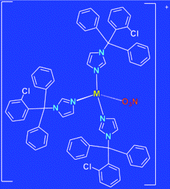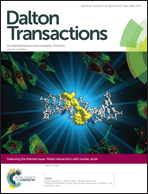Redox-active and DNA-binding coordination complexes of clotrimazole†
Abstract
DNA interactions of anticancer mononuclear Cu2+, Co2+, Zn2+, and Ni2+ complexes with the biologically active ligand clotrimazole (clotri) are reported. To fully characterize DNA binding modes for these complexes of the formulae [M(clotri)2Cl2]·nH2O (1–4), [M(clotri)2Br2]·nH2O (5,6), [M(clotri)3NO3]NO3·nH2O (9), and [M(clotri)3(NO3)2] (10), circular dichroism (CD) and linear dichroism (LD) spectroscopy, UV melting experiments, atomic force microscopy (AFM) and ethidium bromide (EtBr) displacement methods were used. Results indicate mixed electrostatic interactions, possibly through groove binding, that result in accretion and coiling of DNA. Electrochemical studies indicate that the Cu2+ complex 9 readily reduces to the reactive-oxygen-species-generating Cu+, which oxidatively damages DNA. There is a subtle correlation between log P values, calculated electrostatic potentials, and cytotoxicity of the complexes. The extent of cell-nucleus DNA-metal adduct formation in the HeLa cervix-uterine carcinoma cell line does not necessarily correlate with cytotoxicity, indicating that the nature of DNA lesions may be crucial to activity.

- This article is part of the themed collection: Metal Interactions with Nucleic Acids


 Please wait while we load your content...
Please wait while we load your content...